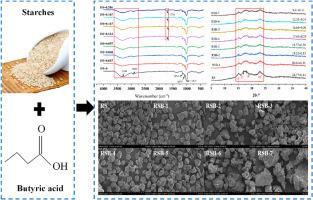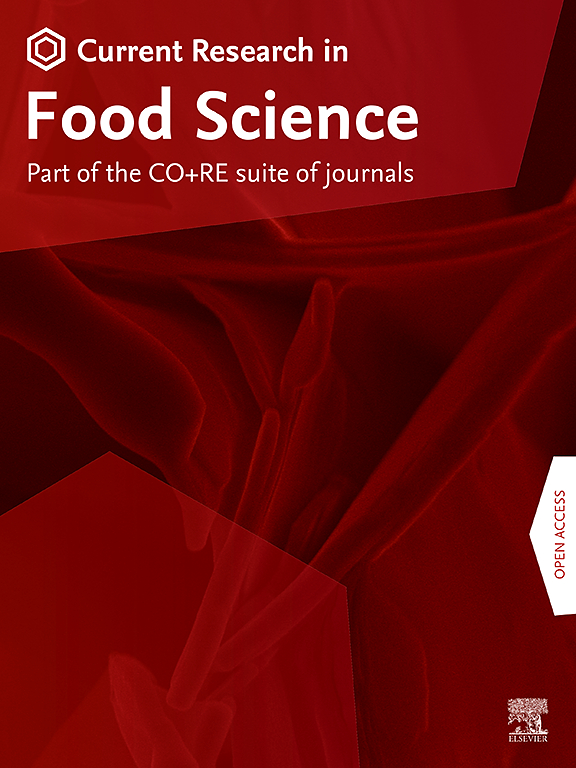Impact of butyric acid modification on the structural and functional properties of rice starch
IF 6.2
2区 农林科学
Q1 FOOD SCIENCE & TECHNOLOGY
引用次数: 0
Abstract
Rice is a food with a high starch content, comprising over 75% of its composition. However, prolonged and excessive consumption of this cereal may lead to elevated blood glucose levels, which can increase the risk of obesity, type 2 diabetes, and cardiovascular disease. Butyric acid (BA), the primary energy source for colonic epithelial cells, exhibits the highest utilization rate among short-chain fatty acids, underscoring its importance for human health. In this study, rice starch butyrate (RSB) samples were synthesized using the aqueous phase process, with broken rice starch (RS) and butyric anhydride serving as the substrate. RSB samples with different degrees of substitution (DS) were produced by modulating the addition amount of butyric anhydride. The crystal structures, morphology of starch granules, pasting properties, thermal stability, and in vitro digestibilities of the RSB were investigated and compared with those of native rice starch. Fourier transform infrared (FTIR) spectroscopy confirmed the successful incorporation of butyryl into the starch molecules. With the increase in DS, the roughness of the RSB material's surface gradually increased, leading to the deterioration of the smooth structure on certain surfaces, which resulted in the appearance of cracks and collapses. Additionally, the crystallinity diminished from 24.77% to 7.41% with increasing DS. Concurrently, in vitro digestive characterisation revealed that the percentage of resistant starch increased from 24.33% to 47.72%. Thus, this study can provide a theoretical basis for the development of novel products of amyl butyrate.

丁酸改性对大米淀粉结构和功能特性的影响
大米是一种淀粉含量很高的食物,占其成分的 75% 以上。然而,长期过量食用这种谷物可能会导致血糖水平升高,从而增加肥胖、2 型糖尿病和心血管疾病的风险。丁酸(BA)是结肠上皮细胞的主要能量来源,是短链脂肪酸中利用率最高的一种,凸显了其对人体健康的重要性。本研究采用水相工艺,以破碎的大米淀粉(RS)和丁酸酐为底物,合成了大米淀粉丁酸盐(RSB)样品。通过调节丁酸酐的添加量,制备出了不同取代度(DS)的 RSB 样品。研究了 RSB 的晶体结构、淀粉颗粒形态、糊化性能、热稳定性和体外消化率,并与原生大米淀粉进行了比较。傅立叶变换红外光谱(FTIR)证实丁酰基成功地加入到淀粉分子中。随着 DS 的增加,RSB 材料表面的粗糙度逐渐增加,导致某些表面的光滑结构恶化,出现裂缝和塌陷。此外,随着 DS 的增加,结晶度从 24.77% 降至 7.41%。同时,体外消化特性分析表明,抗性淀粉的比例从 24.33% 增加到 47.72%。因此,这项研究可为丁酸戊酯新型产品的开发提供理论依据。
本文章由计算机程序翻译,如有差异,请以英文原文为准。
求助全文
约1分钟内获得全文
求助全文
来源期刊

Current Research in Food Science
Agricultural and Biological Sciences-Food Science
CiteScore
7.40
自引率
3.20%
发文量
232
审稿时长
84 days
期刊介绍:
Current Research in Food Science is an international peer-reviewed journal dedicated to advancing the breadth of knowledge in the field of food science. It serves as a platform for publishing original research articles and short communications that encompass a wide array of topics, including food chemistry, physics, microbiology, nutrition, nutraceuticals, process and package engineering, materials science, food sustainability, and food security. By covering these diverse areas, the journal aims to provide a comprehensive source of the latest scientific findings and technological advancements that are shaping the future of the food industry. The journal's scope is designed to address the multidisciplinary nature of food science, reflecting its commitment to promoting innovation and ensuring the safety and quality of the food supply.
文献相关原料
公司名称
产品信息
阿拉丁
Butyric anhydride
 求助内容:
求助内容: 应助结果提醒方式:
应助结果提醒方式:


